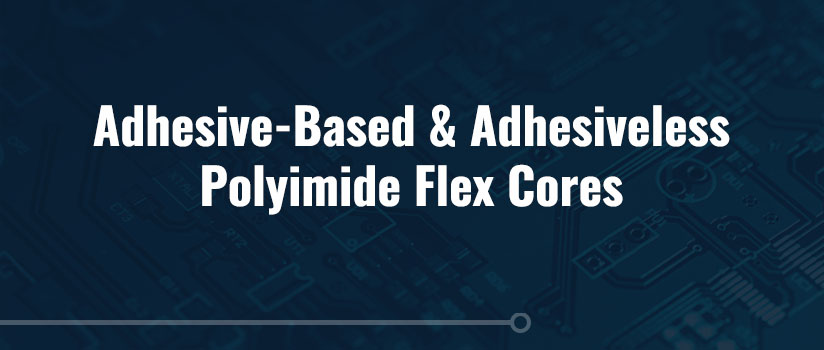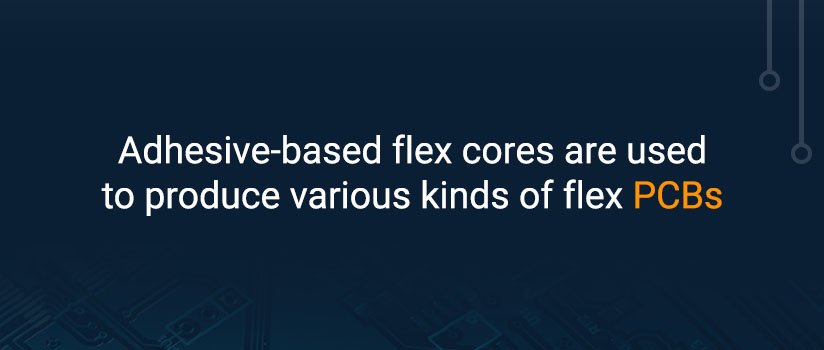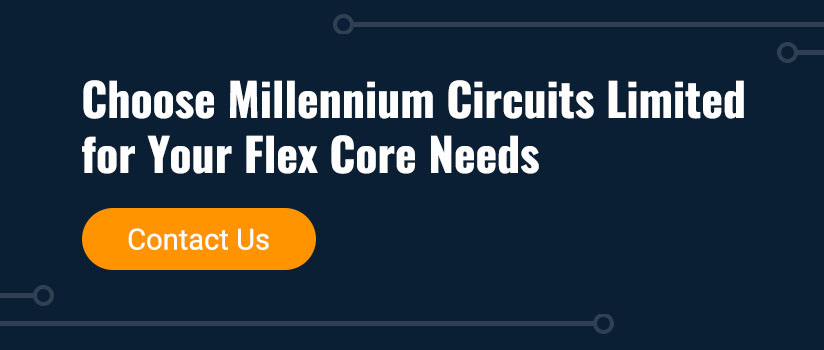Adhesive-Based and Adhesiveless Polyimide Flex Cores
When a company needs a flexible printed circuit board (PCB), they’ll often choose between adhesive and adhesiveless polyimide flex cores. These polyimide flex PC material types offer different advantages and are more suited for certain applications. If you’re in the market for a flex PCB, you’ll often have the choice between adhesive and adhesiveless offerings, meaning you’ll likely want to know how these polyimide flex PCB material types differ.
Find out more about what adhesive and adhesiveless polyimide flex cores are, their benefits and their primary applications.
Adhesive-Based Flex Cores
Adhesive-based flex cores feature a flexible adhesive that bonds a polyimide PCB core to base copper on either side. Manufacturers use pressure and heat on the adhesive to bond the base copper and the polyimide PCB core together. Generally, the adhesive of flex cores is acrylic or epoxy.
Since acrylic adhesives tend to soften when they’re exposed to heat, manufacturers often use teardrops and anchors in the construction of adhesive-based flex cores. These design components help to reduce the chances of cracks forming in the copper plating within its via holes.
Benefits of Adhesive-Based Flex Cores
Adhesive-based flex cores are an older method of constructing flex cores, but they still have some advantages. Two of the primary reasons companies turn to adhesive polyimide flex cores are their lower material costs and greater copper peel strengths.
- Lower material costs: Since adhesive-based flex cores offer a relatively simple design and manufacturing process, they come with lower material costs. Due to these reduced costs, companies can receive adhesive-based flex cores for a lower price than adhesiveless flex cores. If you’re looking for a cost-effective option, these kinds of flex cores are often an excellent choice.
- Greater copper peel strengths: Another major advantage of adhesive-based flex cores is that they have a higher copper peel strength compared to adhesiveless based flex cores. A core’s peel strength refers to the bond strength between the dielectric material and copper conductor. By having a stronger peel strength, adhesive flex cores can be very durable.
Adhesive-Based Flex Core Applications
Adhesive-based flex cores are used to produce various kinds of flex PCBs. Since these cores tend to have reliability issues, they’re typically only used in environments without harsh conditions. You can find manufacturers using them for single and double-sided flex PCBs. If a PCB requires a higher copper peel strength or a company is looking for a cost-effective solution, they’ll often turn to an adhesive-based flex core.
Adhesiveless Flex Cores
In contrast to adhesive-based flex cores, adhesiveless flex cores don’t use an adhesive. Instead, manufacturers cast the polyimide core onto the copper, removing the need for an adhesive bond. You can typically find adhesiveless flex cores in cast dielectric on copper or sputtered copper on dielectric film constructions. Manufacturers created these flex cores to address some of the reliability issues posed by adhesive-based flex cores.
Benefits of Adhesiveless Flex Cores
Since adhesiveless flex cores were designed to reduce the shortcomings of adhesive flex cores, they come with many benefits. Here are some of the top reasons companies turn to adhesiveless flex cores:
- Reduced thickness: When companies create flex cores, they often want them to be as thin as possible to free up space for other materials. Adhesiveless flex cores help reduce a PCB’s thickness by eliminating adhesive layers.
- Greater flexibility: Since adhesiveless flex cores are thinner and have a lower finished flex thickness, they have greater flexibility. This flexibility assists companies that require more bendable PCBs. The reduced finished flex thickness also makes it so adhesiveless flex cores feature a tighter possible minimum bend radius.
- Higher temperature ratings: Since adhesive-based flex cores tend to crack at higher temperatures, they don’t have a high temperature rating. Due to adhesiveless flex cores’ ability to better handle heat, they have higher temperature ratings. Their higher temperature ratings mean you can use adhesiveless flex cores in harsher environments without worrying about them breaking down.
- Better controlled impedance: Adhesiveless flex cores feature a homogenous construction with a polyimide resting between reference planes and signal layers. Since these cores feature a homogenous construction, they have better-controlled impedance signal characteristics.
- Improved plated through-hole reliability: When manufacturers create flex cores with higher layer count flex designs, adhesiveless flex cores offer improved plated-hole reliability. One of the ways these flex cores achieve this reliability is by reducing the layers of adhesives inside the flex construction. Adhesiveless flex cores also solve the issue of adhesive-based flex cores cracking during assembly and operation due to excessive Z-axis stress.
- Better suited to harsh environments: Adhesiveless flex cores offer greater flexibility, reliability and temperature ratings, so they’re better suited to harsh environments. Due to their ability to handle tougher environments, they’re very popular among companies that know their PCBs will need to handle tough conditions and perform for a long time.
Adhesiveless Flex Core Applications
Due to the many advantages of adhesiveless flex cores, they’re often used in applications requiring a higher layer count. You can find them in numerous applications requiring greater quality and reliability, as these flex cores ensure PCBs hold up in harsh environments. They’re also well suited for flex PCBs needing more flexibility and thinner construction.
Choose Millennium Circuits Limited for Your Flex Core Needs
At Millennium Circuits Limited, we provide our clients with the best adhesive and adhesiveless polyimide flex cores possible. Since both of these polyimide flex core material types have different advantages, we can help our clients select adhesive-based or adhesiveless flex cores for their project. We also offer numerous capabilities and can help your company meet scheduled releases of production quantities and receive prototypes on a quick-turn-around schedule. Since we’re ISO 9001 certified, we can guarantee high-quality products, no matter your needs.
Review our flexible PCB offerings today to find the perfect option for your project. If you have any questions or want information on pricing, please feel free to contact us or request a free quote.




